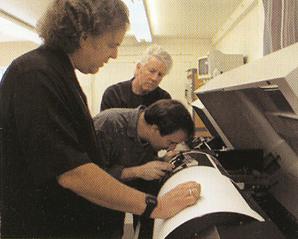Rock, Roll 'n Print
Graham Nash's Introduction, Continued
Joni Mitchell, with whom I was living, once asked if I would be interested in showing my work at the Parco Gallery in Tokyo, where she had recently shown her paintings. She had a wonderful experience there, and I trusted her. I had been a photographer for years, and I'd taken many, many images, but they were personal to me. I rarely showed them to anyone but Joni. She truly believed that I should share them with a wider audience, and so she put me in touch with the gallery. Parco wanted fifty images in an edition of twenty-five, and each one had to be at least 30 by 40 inches. This presented a challenge, but, as normally happens in my life, every time I have a problem I just turn around and the answer is facing me. Finding this digital world and the Iris 3047 was no exception.
Left to right: R. Mac Holbert, John Bilotta and Graham Nash viewing a black-and-white print from an Iris 3047 in 2004. While the first Epson pigmented inkjet printers could produce beautiful color images, they had limitations with black-and-white images and the first Iris printers continued to be used at Nash Editions for black-and-white prints until Epson resolved this shortcoming with a new generation of printer and inks in 2004.
Crosby, Stills & Nash were going to do some shows in Australia, and Mac, as our tour manager, was overseeing the details. Before we left he said to me, "Why do we have this $126,000 printer just sitting here? Maybe our friends and a few artists would like to use it while we're away, and that would at least pay for ink and paper." With the advice and encouragement of friends Charlie Wehrenberg, Steve Boulter, and David Coons, Mac and I started Nash Editions with those modest intentions, allowing our friend Jack Duganne to use the printer until we returned from Australia.
Our main philosophy at Nash Editions is quite simple. We want to make our clients smile. When they see the many options we present, their minds immediately grasp the possibilities and run with them. We never intended to make art that matches a set of curtains or a couch, and we never will. Mac and I and everyone at Nash Editions will always concentrate on the "art" and not the business. That, we believe, is evident on these pages. At Nash Editions we have a collection of the very beginnings of digital printing. The range of artistic endeavor included here is breathtaking and includes paintings, watercolors, and other forms of imagemaking, from Darryl Curran's "scanograms," made directly on the scanner glass, to the works of many traditional photographers who want to use digital technology to achieve the very best image possible. It has never mattered to us how you get there - only how successfully an artist has realized his or her vision and what that image means for your own particular soul.
David Hockney, Second Detail, Snails Space, March 25, 1995.
I've seen a great change in the mindset of many who sat on the fence about whether or not digital photography was collectible. Today, digital pigment prints have higher longevity ratings than other traditional color printing processes, and we have now seen digital prints in many major museum and private collections. So it appears that digital printing has finally found its place, and part of the story of how that happened is represented in this book.
It has always been a privilege to be playing with light this way with my friend Mac. His friendship and partnership have been a joy and have truly enriched my life. For Mac and me this has been quite a journey...and it continues to this day. We have had much help along the way, and for that we are both truly grateful.
Get Tom's Hardware's best news and in-depth reviews, straight to your inbox.
Current page: Graham Nash's Introduction, Continued
Prev Page Graham Nash's Introduction, Continued
